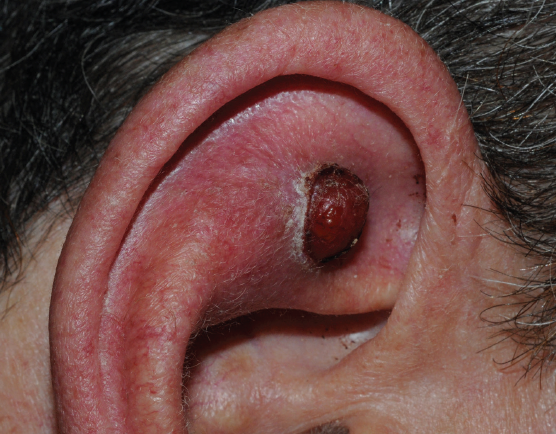What is responsible for this man’s ear tumor?
A 56-year-old male presented with a sudden enlarging tumor on his ear of less than 1 month duration.
There is no previous trauma. He is not immunocompromised.

What could be responsible for the tumor?
A. Squamous cell carcinoma
B. Basal cell carcinoma
C. Amelanotic melanoma
D. Atypical fibroxanthoma
E. Merkel cell tumor
(Answer and discussion on next page)
Answer: Atypical fibroxanthomas
All the choices are reasonable possibilities that can only be answered with a biopsy. The results show atypical fibroxanthoma.

Without looking up the diagnosis, what is your first thought on how to manage this patient?
A. Refer for Mohs surgery to ensure margins
B. Refer to an ear, nose, and throat specialist for adequate margins and lymph node dissection
C. Metastatic work-up prior to any surgical options
D. Refer to radiation oncology to preserve the ear
E. Simple excision with margins
(Answer and discussion on next page)
Answer: Simple excision with margins
Atypical fibroxanthoma is a rare tumor of fibrocytic or myofibrocytic differentiation. The histologic picture is very ominous appearing with atypical multinucleated giant cells and mitoses often being seen.
The characteristics can include aggressive behavior, including involvement of larger portions of the subcutis or deep soft tissues, vascular or perineural invasion, and the presence of necroses. Reports of involvement of lymph nodes are present in the literature.
Fortunately, these lesions typically do well with simple excision with margins though most dermatologists believe frozen section analysis at the time of excision using Mohs surgery is beneficial to ensure clear margins.
Close coordination of care with primary care providers to monitor extracutaneous involvement is advised.


